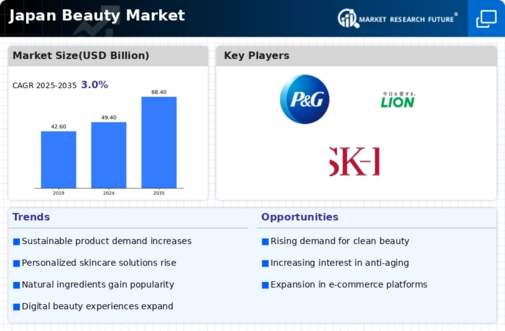Market Trends
Key Emerging Trends in the Japan Beauty Market
The global toothpaste market is in a perpetual state of evolution, driven by the continuous process of product innovation. Since its commercialization, toothpaste has witnessed numerous transformations, with market players recognizing the imperative to meet changing consumer demands through robust Research and Development (R&D) efforts. The surge in demand for innovative products tailored to specific consumer needs, such as teeth whitening, tooth sensitivity, and natural & organic formulations, has become a catalyst for intensified R&D activities and the introduction of groundbreaking products. This focus on innovation not only attracts new customers but also opens up a plethora of growth opportunities for market players. Changing Consumer Demands and R&D Focus: The landscape of consumer demands is ever-shifting, prompting toothpaste manufacturers to invest significantly in R&D to keep pace with evolving preferences. The market is witnessing an upsurge in demand for products that go beyond conventional oral care, catering to specific needs and preferences. Teeth whitening, addressing tooth sensitivity, and the growing inclination towards natural and organic formulations have become focal points for innovation, driving market players to explore novel formulations and ingredients. Market Dynamics and Growth Opportunities: The pursuit of innovation in toothpaste is not merely a strategic choice but a necessity in a dynamic market environment. The introduction of novel and specialized products has not only allowed companies to stay competitive but has also opened up avenues for growth. Market players leveraging innovation effectively are capitalizing on opportunities created by shifting consumer behaviors and preferences, leading to increased market share and profitability. Herbal/Ayurvedic Disruption and Market Dynamics: The launch of herbal/ayurvedic toothpaste by Patanjali Ayurved marked a significant disruption, challenging the market position of established players like Colgate-Palmolive, particularly in the Indian market. This move not only underscored the demand for natural formulations but also offered opportunities for other players like Dabur to capitalize on the emerging trend. Responding to this shift, Colgate-Palmolive later entered the ayurvedic toothpaste segment, showcasing the adaptive nature of market leaders in the face of evolving consumer preferences. This example illustrates how product innovation, driven by market dynamics, can not only pose challenges but also create lucrative opportunities for both established and emerging players. Global Expansion Through Innovative Formulations: In April 2017, GlaxoSmithKline made a significant foray into the US market with the introduction of ProNamel Strong & Bright toothpaste. This innovative formulation was designed to address the specific dietary challenges faced by consumers in the United States, offering strength and protection to tooth enamel. The successful launch of this product highlights how global expansion can be facilitated through the introduction of innovative formulations that resonate with the needs of diverse consumer bases. The Crucial Role of Product Innovation: Product innovation emerges as a cornerstone in the growth and sustainability of the global toothpaste market. As market players navigate the dynamic landscape shaped by changing consumer demands, they recognize the pivotal role of R&D in creating products that meet specific needs and preferences. The examples of herbal/ayurvedic toothpaste, natural formulations, and region-specific innovations underscore the adaptability and resilience of market players. In a competitive environment, where consumer choices are influenced by a myriad of factors, product innovation not only drives sales but also defines the success and market positioning of toothpaste brands globally. As the market continues to evolve, those at the forefront of innovation are poised to seize new opportunities, ensuring sustained growth and relevance in the ever-changing world of oral care.






Leave a Comment